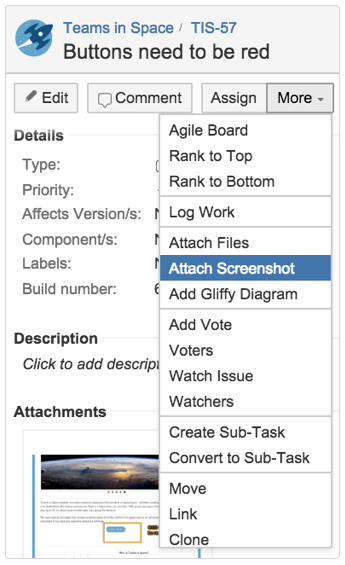Getting the right data from users to ease developer pain
Collecting the right information from the start makes interactions between the development team and issue reporters much easier. In this article, I'll share a few ways you can help ease developer pain with JIRA Software.
Successful product teams incorporate user feedback throughout their entire development cycle. Product owners meet with customers, and development teams respond to bug reports both internally and from the field. For user feedback to be helpful to the program, it needs to be actionable. For the developers in the audience, how many of you have seen bug reports like this?

For a developer, that type of bug report doesn’t provide much to go on. Poorly formed issues are big pain points for developers. We walk through a couple of scenarios and find that the feature is working as designed, so we then report back to the reporter that the bug isn't reproducible. So begins a long back-and-forth session with the reporter for more detailed information. How can we better empower people who report issues to give us the information we need right from the start?
This outreach is one of the most beneficial things development teams can bring to the user feedback cycle.
Explain how to get the right data
Many teams use the power of custom fields inside of JIRA Software. Custom fields allow development teams to track data points that are specific to their program, which are critical to understanding and resolving issues. The problem is, the further removed the reporter gets from the development team, the less they understand about the product, development environments, and which data points are needed to fix a particular bug.

In JIRA Software, administrators can add explanatory text to each custom field by creating a page in Confluence that explains how to file a bug for your product. In the Confluence page, explain what each field is and how to collect that data inside of the product. For example, the build number is a relevant data point for many teams. Inside of the how-to article, explain where to get the build number. Then, link to that section of the document from JIRA Software's custom field description. If the user doesn’t understand how to get the build number, they can simply click on the link and get step-by-step instructions.
Encourage explanatory screenshots
If it's difficult to explain the entire situation in words, adding a screenshot will help clarify. Adding attachments to issues in JIRA Software is simple.

Integrate with JIRA Software's REST API
Development teams can go even further by integrating with JIRA Software's REST API. Sometimes, users aren't able to get detailed, critical information out of the application. Empower your application to communicate with JIRA Software by creating new issues or enhancing data of existing issues.
Creating issues
Some teams have integrated the JIRA Issue Collector inside of their application. The issue collector is a small snippet of HTML and JavaScript that facilitates logging feedback into a predetermined JIRA Software project. The reporter doesn’t even have to be a JIRA Software user.
Teams that want a tighter integration with JIRA Software can simply use the REST API to file issues directly. Users can log in to JIRA Software from within your application, and the application can file a bug on behalf of the user. The application collects a summary and description from the user, and programmatically includes detailed environmental information, like build number, log files, and potentially the stack trace.
Collecting data in a structured fashion makes it easier for the development team to triage these issues. The data is structured in a consistent way in each and every issue. As the team learns which data is important, over time, they can tweak the integration between their application and JIRA Software. To learn more about creating issues with the REST API, browse our developer documentation at developer.atlassian.com.
Adding to existing issues
The REST API can be used to add additional information to existing issues. The user can file an issue inside of JIRA Software and point the application at a particular JIRA Software ticket. The application can then report the same type of data as above, but without requiring a user login. To learn more about editing existing issues with the REST API, browse our developer documentation at developer.atlassian.com.
Minimize developer pain: connect users with developers
You’re probably thinking, “why make the investment?” Minimizing the time spent on technical debt frees the team to focus on new innovation. If you’re not convinced, I’d suggest running the following JQL statement to see how many issues the team cycles needlessly.
1 | status was “resolved” |
I’m checking to see how many issues got resolved as "cannot reproduce" by the development team. If there’s a significant number, it’s indicative that the development team is not getting the information they need from the user base.
What creative ways have you integrated JIRA Software inside of your applications?
Hungry for more?
Watch the blogs in this space to get notified when new tips articles like this are posted. And if that's still not enough, sign up for JIRA Insiders – our monthly newsletter covering all things JIRA.
![]() Written by Dan Radigan, Technical Account Manager
Written by Dan Radigan, Technical Account Manager
